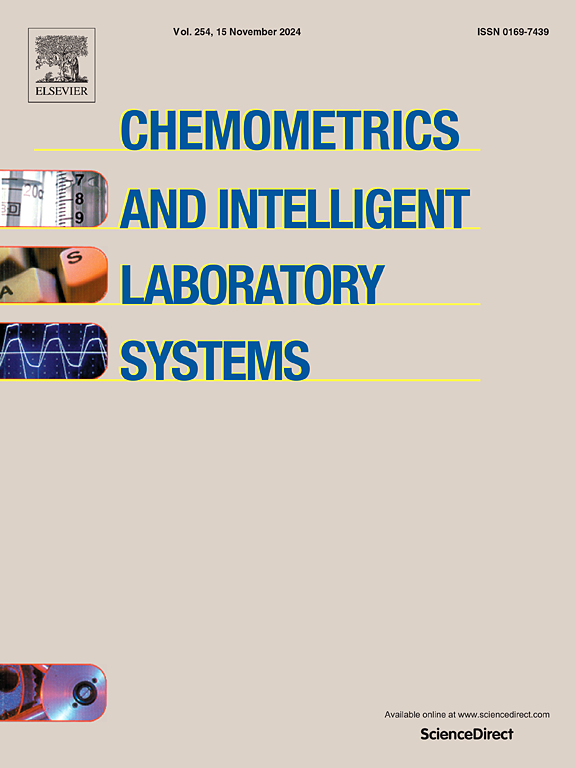实施人工智能和多元分析,分析受海水影响的农业土壤的电学和理化性质
IF 3.8
2区 化学
Q2 AUTOMATION & CONTROL SYSTEMS
Chemometrics and Intelligent Laboratory Systems
Pub Date : 2025-08-30
DOI:10.1016/j.chemolab.2025.105520
引用次数: 0
摘要
随着全球变暖和城市化进程的推进,盐碱化对土壤的影响已成为一项重大的环境挑战。土壤的电特性受到土壤的物理化学特性、盐度、水分含量和地质特征的复杂影响。这项工作旨在利用基于pc的自动化微波x波段实验方法,在9.55 GHz频率下使用“无限样本”技术,评估农业、河岸带和近海滨盐沼土壤的电学和化学性质。此外,采用实验室方法对土壤样品的pH、钠吸收比(SAR)、交换钠百分率(ESP)、有机碳(OC)、磷(P)、钾(K)、微量元素(Fe、Mn、Cu和Zn)等化学性质以及孔隙度(PO)、颗粒密度和容重(PD和BD)等物理性质进行了测量。此外,采用层次聚类分析(HCA)和主成分分析(PCA)根据样本的性质对其进行分类和区分,从而深入了解潜在的模式和分组。为了准确估计介质常数和介质损耗,我们采用了多元线性回归(MLR)和人工神经网络(ANN)模型。采用均方根误差(RMSE)和决定系数(R2)等统计指标评价所建模型的性能和预测准确性。以PO、BD、PD、P、OC、K和ESP为输入变量的神经网络模型得到的介电常数R2和RMSE分别为0.99和9.23 × 10−04,介电损耗分别为0.98和2.93 × 10−02。MLR的介电常数和介电损耗R2分别为0.88和0.80。SHapley加性解释(SHapley Additive exPlanations)分析结合人工神经网络模型,发现DC受可交换钠百分比(ESP)的影响,而DL受影响较小。因此,ANN和SHAP能够准确预测土壤的介电特性,为监测盐分对土壤健康的影响提供了一种无损且有效的方法。本文章由计算机程序翻译,如有差异,请以英文原文为准。
Implementation of artificial intelligence and multivariate analysis to analyze electrical and physicochemical properties of seawater-affected agriculture soil
The impact of salinity on soil has become a major environmental challenge due to global warming and urbanization. The electrical properties of soil are intricately influenced by physicochemical properties, salinity levels, moisture content, and geological features of the land. This work aimed to evaluate the electrical and chemical properties of the agricultural, riparian zone, and near-seafront salt marsh soils using a PC-based automated microwave X-band bench method at frequency 9.55 GHz with ‘infinite sample’ technique. Also, Chemical properties such as pH, sodium absorption ratio (SAR), exchangeable sodium percentage (ESP), organic carbon (OC), phosphorous (P), potassium (K), micronutrients (Fe, Mn, Cu, and Zn), and physical properties such as porosity (PO), particle and bulk density (PD and BD) of soil samples were measured using laboratory method in triplicate. Furthermore, Hierarchical Cluster Analysis (HCA) and Principal Component Analysis (PCA) were employed to classify and differentiate samples based on their properties, providing insights into underlying patterns and groupings. To accurately estimate the dielectric constant and dielectric loss, we implemented Multiple Linear Regression (MLR) and an Artificial Neural Network (ANN) model using a feed-forward back propagation. To evaluate the performance and predictive accuracy of the developed models, statistical metrics such as Root Mean Square Error (RMSE) and the coefficient of determination (R2) were used. The R2 and RMSE values of the dielectric constant obtained by the ANN model with PO, BD, PD, P, OC, K, and ESP as entered variables were 0.99 and 9.23 × 10−04, and for dielectric loss, were 0.98 and 2.93 × 10−02, respectively. For MLR, the R2 value of the dielectric constant and dielectric loss was 0.88 and 0.80. SHAP (SHapley Additive exPlanations) analysis, combined with an ANN model, revealed that the DC is influenced by the Exchangeable Sodium Percentage (ESP), while DL minutely affected. Thus, ANN and SHAP accurately predicted dielectric properties of soil, offering a nondestructive and efficient approach for monitoring salinity effects on soil health.
求助全文
通过发布文献求助,成功后即可免费获取论文全文。
去求助
来源期刊
CiteScore
7.50
自引率
7.70%
发文量
169
审稿时长
3.4 months
期刊介绍:
Chemometrics and Intelligent Laboratory Systems publishes original research papers, short communications, reviews, tutorials and Original Software Publications reporting on development of novel statistical, mathematical, or computer techniques in Chemistry and related disciplines.
Chemometrics is the chemical discipline that uses mathematical and statistical methods to design or select optimal procedures and experiments, and to provide maximum chemical information by analysing chemical data.
The journal deals with the following topics:
1) Development of new statistical, mathematical and chemometrical methods for Chemistry and related fields (Environmental Chemistry, Biochemistry, Toxicology, System Biology, -Omics, etc.)
2) Novel applications of chemometrics to all branches of Chemistry and related fields (typical domains of interest are: process data analysis, experimental design, data mining, signal processing, supervised modelling, decision making, robust statistics, mixture analysis, multivariate calibration etc.) Routine applications of established chemometrical techniques will not be considered.
3) Development of new software that provides novel tools or truly advances the use of chemometrical methods.
4) Well characterized data sets to test performance for the new methods and software.
The journal complies with International Committee of Medical Journal Editors'' Uniform requirements for manuscripts.

 求助内容:
求助内容: 应助结果提醒方式:
应助结果提醒方式:


